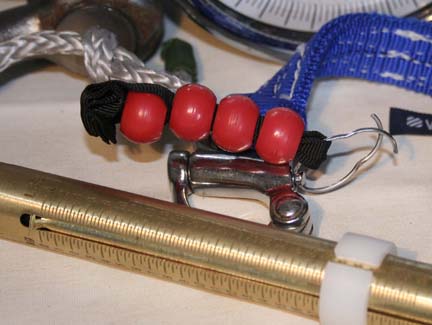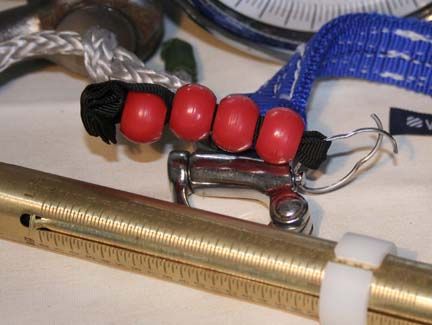
I am floored by the amount of great feedback we’ve been getting from readers regarding our tether-harness/PFD design project, which is still very much in the embryonic stage. At this point, we are still soliciting ideas from the public regarding what sort of criteria to set for the ideal tether and ideal harness/PFD. From the looks of the great ideas we’ve been getting, we’ll likely have two, possibly three different designs. Please, if you have any suggestions for this project—problems or solutions you’ve found in your own experiences on the water—send them via e-mail to [email protected]. Let us know if you have attachments or illustrations you’d like to send.
While a harness and tether arrangement might seem fairly straightforward, there are at least a dozen different key elements in the design. And just to illustrate the complexity of the PFD/harness project, I’m going to narrow the focus to just one element on the tether: the release lanyard.
The release lanyard on a modern tether is typically a short length of webbing attached to the snap shackle that connects to the harness. Pull on the lanyard, and the snap shackle releases. Being able to release from a tether is a requirement for offshore sailing and essential to avoid drowning (when you must get free of a capsized or sinking vessel, for example), and the release is often necessary for disentangling yourself from running rigging while working on deck. Countless sailors have been momentarily lifted off deck by a spinnaker guy, or found themselves in a situation where releasing the tether is the only way to escape more serious injury.
Assuming our ideal design will still have a snap-shackle—not a given—lets look at the things we’ll need in the lanyard.
- Distinct appearance and feeling. The lanyard must be easy to find in the dark, in the water, when the sailor is on the verge of panic.
- Easy to grip, even with gloves. Our tests indicate that the amount of pull required to open existing snap shackles while under load is about 35 pounds or more.
- Difficult to snag. The last thing we want is something that will get snagged on a shroud or piece of hardware as were moving forward on deck.
- A secure means of attaching the lanyard to the snap shackle. Past designs have relied on split rings that have proven to be prone to failure.
- Accessible. As weve mentioned before, the lanyard must be accessible when the harness is inflated or deflated.
Looking back at past tether designs, it’s easy to see how manufacturers have wrestled with the snap-shackle lanyard problem. For a while, the most popular solution was a 3- to 4-inch flat webbing lanyard with three or four round plastic beads strung on the end. The beads gave you something to grip, were not prone to snagging, and had a very distinct feel in the dark. However, when you tried to apply the required force to these balls, they tended to slip out of your hands, particularly wet or gloved hands.
A couple years ago, West Marine and other makers introduced a lanyard with a rubberized, triangle-shaped finger pull at the end. This offered somewhat better grip, but was more prone to snagging than the beads. Designs with this type of pull were voluntarily recalled by West Marine in 2010 due to reported problems with the split-rings.
Some more recent tethers have neither beads nor a finger pull, but a simple flat loop of webbing that is much less prone to snagging, but more difficult to locate by feel. This design is also difficult to grab until you open the loop up so you can insert a finger or two inside for pulling. This, in my view, is a step backward from the bead lanyards.
One arrangement I’ve contemplated is a toggle, something you can grab with your middle and forefinger with the lanyard between, but this, too, seems prone to snagging. Which made me wonder whether there wasn’t a cheap, convenient way to stow these easier-to-grab, but easier-to-snag lanyards so that they wouldn’t get caught on something.
While I was noodling the range of imperfect options for this seemingly simple component, Technical Editor Drew Frye, an avid rock climber, pointed me to Yates Gear, maker of safety tethers for commercial, rescue, and military use, as well as for recreational climbers.

According to John Yates of Yates Gear, many of the problems we’ve encountered with lanyards, such as the split-ring failure, have already been encountered in some military situations, and have been solved. If you look at the Ronstan snap shackle used on its Heavy Duty Personal Retention Lanyard (item #563B-6300), you’ll see that they actually use a small shackle instead of a split ring. I also noticed that the tethers used as personal retention lanyards in military helicopters, where you want no chance of opening, incorporate the Kong Tango double-locking hook on the harness end, not a quick release. The drawback of this Kong is that it cannot be released under load, but that is the sort of compromise you learn to live with when you are hovering well above sea level.
Finally, I noticed that most of the snap shackle release lanyards are made of thicker, easier-to-grab webbing; some have a loop, others have a small ring on the end where one might attach a ball or toggle. All of them attach to the tether itself using a bit of Velcro fastener. That way they don’t flop around where they might get snagged. According to Yates, the Velcro helps prevent the accidental-pull scenario. Now, my experience with Velcro in the real world is that it doesn’t last forever, but this nevertheless seems like a possible solution.
Another thing I noticed was the use of the Ronstan 6200 (with a TIG welded split-ring, used in the QR Personal Retention Lanyard) and Ronstan 6300 swivel snap shackles, which we have not seen in the recent marine tether designs we’ve looked at. According to Yates, the Ronstan 6300, used in the Yates Heavy Duty QR Personal Retention Lanyard, has been tested as capable of opening at loads up to 500 pounds.
I don’t want to appear that were endorsing the Yates tethers, which we havent tested and arent explicitly designed for the marine market-although most of the components seem to meet or exceed the essential standards set for existing marine halyards. One key component missing is the tether overload indicator, a stitched-in flag that indicates that a tether has been loaded beyond a safe point and needs to be replaced. This only really matters if you are going to race, since the overload indicator is required in most major racing events.
However, if you, like me, are mulling over ideas on how to improve the gear your life may one day depend upon, hop on over to the Yates Gear website and see what sort of equipment tower climbers, the military, and rescue workers are relying on.








































